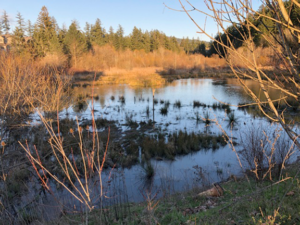Area wetlands gain a footing again—with help

The nature of Cedar Mill
by Susan Mates
It’s no accident that Oregon is named “The Beaver State.” Beaver-created wetlands historically laced this entire region. Often called “nurseries of life,” wetlands provide important habitat for thousands of species of plants and animals.

Wetlands also are key to water filtration, absorbing pollutants that run off from our yards and roads, and slowing floodwaters. And they are great spots for birdwatching or for finding some peace and quiet.
But wetlands, which are among the world’s most economically valuable ecosystems and essential regulators of the global climate, are disappearing three times faster than forests. Nearly half of all wetlands in the mainland U.S. have been destroyed by development. Here, in Cedar Mill, we are lucky to be able to enjoy some remaining wetlands close to home. If you don’t know them already, you have a treat in store.
Cedar Mill Wetlands
These 16 acres along Barnes Road were a wetland filled with beaver where North Johnson Creek and its tributaries wandered through the floodplain. Once drained to become a horse pasture, the rich soil was later used to grow thirsty crops, including green beans that local children picked in the summers.
In the 1980-90s, Barnes Road was realigned, and the Sunset Transit Center was built. The US Clean Water Act requires that development impacting wetlands is to be offset, or mitigated, by the creation and/or enhancement of a wetland in another (hopefully nearby) location. As a result, Metro, Trimet and Washington County together reconstructed Cedar Mill Wetlands as a mitigation project.
Now the wetland is owned by The Wetland Conservancy, the only organization in Oregon dedicated to permanently protect and conserve Oregon wetlands. They have worked miracles here with the help of volunteer efforts and community involvement.

In the late 1990’s, this area was still a raw, swampy area of invasive plants, plant marker sticks, and optimism. Today it has become a wildlife-rich habitat that includes year-round ponds, forested uplands, scrub-shrub areas, and wet meadow communities. It is home to beaver, newts, deer, reptiles and more than 100 species of birds.
The Wetland Conservancy relies on community volunteers to help maintain and protect this wetland. Restoration parties remove invasive plants and replace them with native species. Citizen scientists don waders to conduct beaver studies and amphibian egg mass surveys in this and other wetlands, proving that nature does its best to restore itself. Even sensitive native species such as Northern Red-legged frogs (Rana aurora) have made a comeback here.
A path winds around the northwest part of the wetlands and can be accessed from SW Barnes Road or from NW Cedar Falls Drive. This time of year you can hear the “conk-la-ree” trill of red-winged blackbirds, and see where beaver have gnawed off the alder trees that ring the ponds. Treekeepers of Washington County has created a trail map that showcases some of the trees along this path.
We will highlight some of our other wetlands in upcoming issues. Which one is your favorite?





